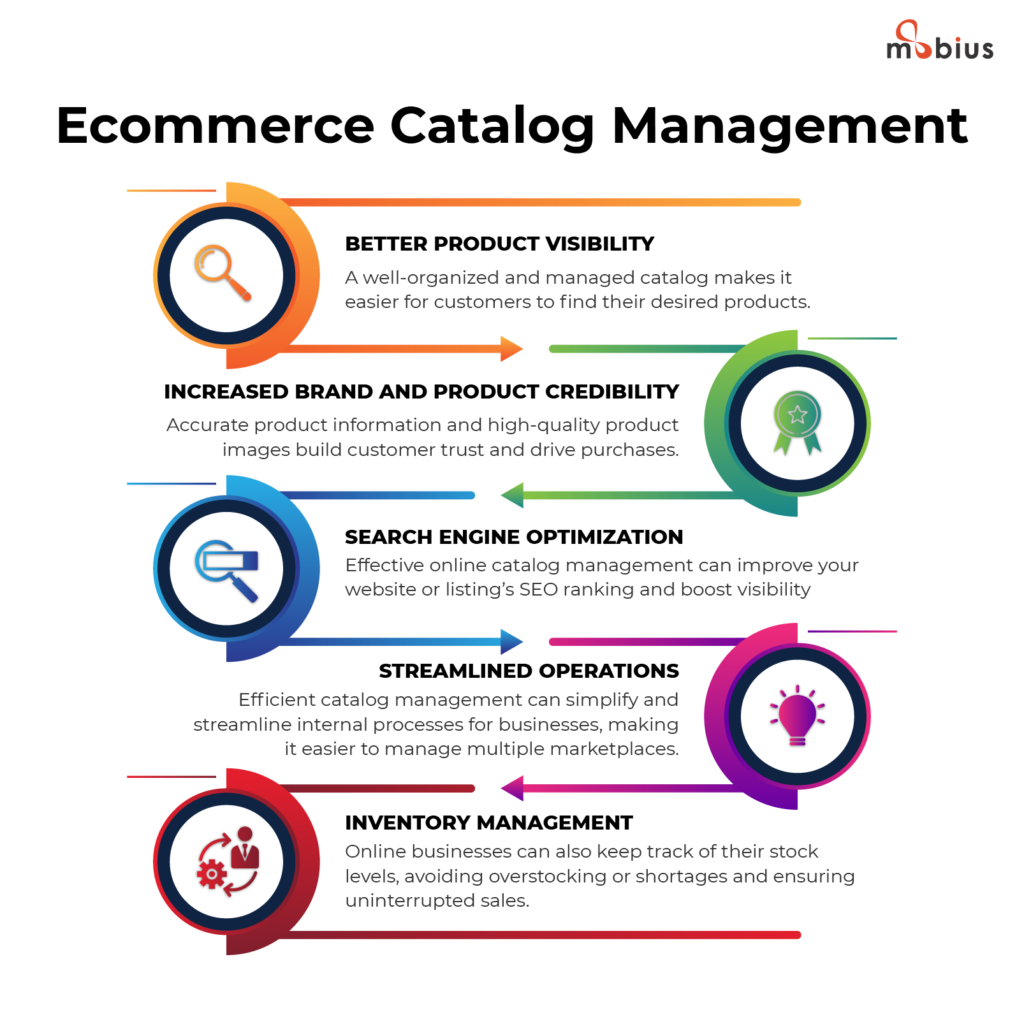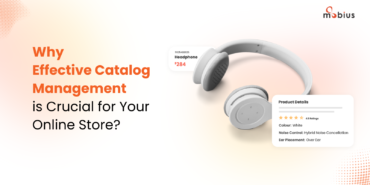Ecommerce product catalogs help online shoppers make purchase decisions by displaying necessary product details like features, images, and videos. Therefore, ecommerce catalog management is invaluable to every ecommerce business in driving sales. Brands, retailers, manufacturers, and distributors must create immersive, information-rich experiences for shoppers to ensure they convert.
Of course, when a shopper lands on your ecommerce site, they know what they are looking for. They probably already know what or how the product looks like. So, what makes having detailed product catalogs so crucial? Online shoppers today are faced with infinite options, whether it’s narrowing down a product or a marketplace (to buy from). And their decision boils down to the pricing and buying experience you offer.
With detailed product catalogs, you enable shoppers to compare your products against other products or sellers conveniently and make a quick purchase decision. These decisions are usually based on pricing, product details, delivery, etc. Finding all this information in your product catalogs makes it easier for them to compare and decide. This builds confidence among your customers and motivates them to make a purchase.
Now, for brands and retailers with a limited volume of products, it might be fairly easy to manage catalogs manually. But, it might not guarantee accuracy and swiftness. However, it is even more challenging for mid to large-sized brands and retailers with more than 1000K products to manage catalogs manually.
This blog will discuss ecommerce catalog management, its importance, and how you can effectively manage product catalogs to boost shopper experience and increase sales.
What is ecommerce catalog management?
Ecommerce catalog management refers to organizing and maintaining a product database with complete and accurate information. It involves creating, updating, and managing product information, images, descriptions, prices, and other relevant details. This ensures a consistent representation of the product offerings on your website or marketplace.
Ecommerce catalog management aims to provide customers with a seamless shopping experience by offering them up-to-date, accurate, and complete information about the products available.
Ecommerce catalog management is crucial for online businesses as it improves user experience and can contribute to increased sales. With the ecommerce industry’s aggressive competition and the world spiraling into a recession, it is almost impossible to increase sales unless you stand out amongst competitors.
By offering an exceptional shopping experience, you make shoppers choose you over your competitors and improve your chances of building brand loyalty. There’s nothing more satisfying for an online shopper than finding all critical information about the product to aid their decision-making.
Here are a few more benefits of ecommerce catalog management that can affect the success of your online business.

Top 5 ecommerce catalog management tips
1. Ensure correct and complete product information
Product catalogs would not serve their purpose if they are incomplete or contain incorrect information. And this is one of the top challenges brands and retailers face in maintaining catalogs online. Most product data is scattered across manufacturer or retailer sites in an unstructured format. It is almost impossible for ecommerce businesses to find, aggregate, and structure product data in a channel-compliant format.
Although ecommerce catalog management sounds like a simple process, the reality is far from it. It involves multiple processes, including collecting, validating, and enriching product data and integrating the data with the platforms as a final step. It is crucial that high accuracy levels be maintained from the beginning of the data collection process. The rest of the steps are compromised if the data collected is erroneous.
Therefore, ecommerce catalog management solutions use powerful AI product-matching algorithms to accurately match your products across the retailer or manufacturer sites before capturing the product data. It allows precise data collection and validation and ensures your digital catalogs are enriched with up-to-date and precise information.
Having high-quality and complete data on your site builds confidence among your customers and encourages them to conduct business with you.
2. Centralize ecommerce product database
The main goal of every ecommerce business is to find ways to increase its revenue. Ecommerce catalog management is nothing but managing information and requires you to build and maintain a clean database. A centralized product catalog database can aid brands and retailers in improving quality, reducing time-to-market, and increasing customer loyalty and return rates.
Maintaining a single source of information for your digital catalogs allows you to make changes and updates in a single shot across listings, saving time and preserving consistency. When shoppers see consistent information about a product on different websites or marketplaces, it builds trust and confidence.
Moreover, a product catalog database allows you to authorize different stakeholders with set roles for making changes to the database. The authorization option is crucial as it can help you maintain data quality and mitigate data redundancy issues.
3. Maintain consistent attributes and categories
Well-defined product attributes and categories aid online shoppers in finding the right product and make it easier for brands and retailers to add new products. Systematic tagging and categorizing products allow shoppers to filter, sort, and refine online product information in a few clicks.
To make product filtering effortless, brands and retailers must ensure product listings include critical attributes like:
- Size
- Price and deals
- Color
- Dimensions
- Material
- Availability
The attributes you take into consideration to enable filtering might depend on the specific product category or type. This would answer shoppers’ questions about the product before making a purchase. For example, if a shopper is looking for a winter jacket, they would want to know the size, fabric, if it is waterproof, how well it can withhold cold, and so on.
Also, brands must ensure that product tags are consistent across listing sites. If you use the label “Large” on your website, then it is suggested that you stick to the same naming convention rather than tagging a product as “L” on a different marketplace listing.
Furthermore, if you plan to add new products to a category, you must ensure that the product relates to the category logically.
4. Update digital catalogs regularly
Ecommerce catalog management is a continuous process. Shoppers need the relevant and latest information to make purchasing decisions. Therefore, ensuring that the product titles, features, and descriptions are updated with the latest specifications is necessary. This includes changes in prices, dimensions, and sizes.
For instance, ecommerce sellers cannot keep the same price for a product for days. The price needs to be changed based on demand or market trends like the holiday season, events, popularity, and many other factors. If the product catalogs do not reflect these changes in time, you risk losing sales.
A centralized product catalog database can make this whole process easier by letting you make the changes on multiple marketplaces in one go. This way, you can streamline the periodical audit of your product catalogs and display the most current information to your shoppers.
5. Select the right catalog management solution
Every ecommerce business need is different and there is no one size fits all solution when it comes to catalog management. You need a product catalog management solution that aligns with your business goals and is easily scalable. Remember that the goal here to achieve maximum level of automation, reducing the burden and risks of manual processes.
Here’s a quick checklist of the most important capabilities to look for in a catalog management solution:
- Accurate product matching using AI algorithms
- Supports different data formats from various systems
- Sources high-quality product information
- Allows quick changes with product information management (PIM) system
- Meets the specific needs of different marketplaces
- Distributes product content across websites or marketplaces
The right catalog management solution would make aggregating all the product data from different sources like a manufacturer or third-party websites easier and provide a consistent data format, ready to be displayed online. Also, before you commit to a catalog management solution, check if it is scalable and customizable.
Conclusion
While ecommerce catalog management is vital for your business’s growth, managing product catalogs and ensuring they are always up-to-date is equally challenging. It requires a lot of time and workforce to manually create and manage online catalogs, especially when you have a massive inventory and sell on multiple marketplaces.
We understand that managing an ecommerce business, staying on top of technological advancements, and applying them to your business is not always possible. Therefore, we built solutions that take the load off of companies and deliver the expected results quickly.
Let the data and ecommerce experts manage your ecommerce product catalogs while you focus on managing and governing your online business. Connect with us to get a quick understanding of how our catalog management solution can work the best for your business.







1 Comment
Thank you for sharing this informative blog post on eCommerce catalog management. The five tips provided by the author for effective eCommerce catalog management are highly actionable and well-explained. this post provides a great overview of eCommerce catalog management best practices and is a must-read for any eCommerce business looking to improve their online presence. Thank you for sharing this valuable information.